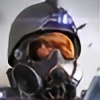HOME | DD
 FlorentLlamas — Soldier 2
FlorentLlamas — Soldier 2

Published: 2014-03-13 01:24:57 +0000 UTC; Views: 15023; Favourites: 332; Downloads: 429
Redirect to original
Description
Photobash and paint again !






llamas.cghub.com
Related content
Comments: 15

I see the back of the latest flight helmet technology.
👍: 0 ⏩: 0

Hehe
Why no camo on the helmet?
👍: 0 ⏩: 0

Love the detailing on the helmet - makes me wonder what the dimples are for...
👍: 0 ⏩: 1

I'm guessing combat fiber optical sensors. Integration between proximity and ambient light sensors, and whatnot.
👍: 0 ⏩: 1

Works for me. (If they were micro cameras they could be feeding a blended 360 FOV in to the front viewing frustrum of the solider's HUD.)
👍: 0 ⏩: 1

That would make the HUD's range-of-view limited and the system way too "busy", I would think. Like the difference between walking down a street in Reno and New York City. And, as an alternative, an updated tac-map (given a permanent stationing of small overhead surveillance drones) would be more viable. As "video gamer" as it sounds, it would be a lot simpler on the operator and the coding if you just used whatever sensor to alert you, via red indicator, for anybody who isn't "tagged" as a friendly. Like that of those damage indicators in those new FPSs, only for unknown presences.
The only downside to that idea is where it would be challenged. How do we tell civvie from enemy combatant, or how do we send potential suicide bombers. The former is an issue because most optical sensors can't tell the skinny front end of a rifle barrel from a walking cane; which could lead to a court martial if you killed an elder who was walking down the street. I could talk about thermal visual sensors, to tell the difference between a set-temped human body and a recently fired assault rifle or light machine-gun, and blah blah blah.
You get the point.
👍: 0 ⏩: 1

The current Generation of military aircraft such as the Joint Strike Fighter use the Distributed Aperture System (DAS), this feeds the views from cameras mounted all over the airframe into the the pilot's HUD, effectively rendering the airframe invisible to the pilot (i.e. he can look down and 'through' the aircraft when coming into land on an aircraft carrier.)
There are already several military spec multi-spectral sensors that will enhance normal visual spectrum optics that will, with practice, allow a warfighter to tell the difference between visually similar objects that look very different in the IR, UV or microwave ranges of the EM spectrum. (So we will be able to 'see' through clothing and identify the much denser plastic explosive (and ball-bearings, nails etc) - there are of course ethical rather than technological issues with this...)
👍: 0 ⏩: 1

That's right. Now, the issue. Getting it from the 5th-Generation fighter, and high dollar count, to the ground soldier for an extremely lowered cost. I like it. Shame I forgot about that.
👍: 0 ⏩: 1

I suspect such a leap will come not from the big Defence Primes, but from the COTS market - if Google decide to do it, then it'll happen.
(For example Vuzix - better known for their Gaming AR goggles, have already produced a ruggedised military version of some of their glasses)
👍: 0 ⏩: 1

Interesting. Thank you for that. I've never heard of Vuzix. I'll have to Google them.
👍: 0 ⏩: 1

No problem - I hope you find the info useful.
👍: 0 ⏩: 0



















